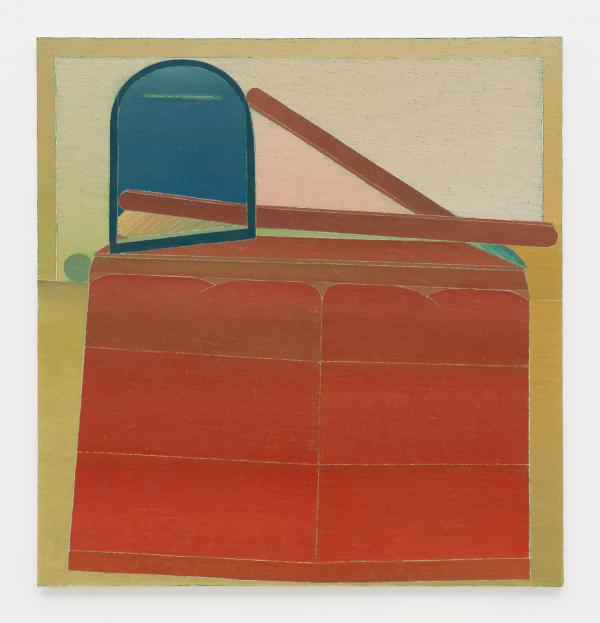Sea Chest (1972) by Miyoko Ito exemplifies what poet John Yau has described as the artist’s “abstract views full of longing and mystery.” On full display in Sea Chest are two unique qualities of Ito’s paintings of the 1970s: her moody, off-key color palettes (ranging here across earthy yellows, rust-tinged oranges, chalky shades of peach, and flights of blue-green); and her semi-surreal compositions blending geometric and organic forms, suggestively hinting at representation while still remaining obdurately abstract.
The singularity of Ito’s practice may explain, in part, her relative obscurity until very recently. Although she lived and worked in Chicago between 1944 and her death in 1983, and was friends with well-known Chicago figures such as Gladys Nilsson, Jim Nutt, and Ray Yoshida, her abstract paintings did not neatly conform to the more graphic and pop-culture informed visual vocabulary of the Chicago Imagists, the artist group with which most of her peers were aligned. Instead, her early works were informed by sources as disparate as Picasso’s Synthetic cubist compositions, Pierre Bonnard’s technique of underpainting, and Giorgio Morandi’s understated still lifes. Later in her career, she told an interviewer, “When I approach a canvas, I try to as much as possible keep my mind blank.” In Sea Chest, like other paintings by Ito from this period, the compositions are partitioned or divided in ways that also suggest horizon lines or imagined landscapes.
Born in 1918 in Berkeley, California, to Japanese-immigrant parents, Miyoko Ito’s life and trajectory as an artist were irrevocably impacted by World War II and the signing in 1942 of Executive Order 9066, which allowed for the forced incarceration of Japanese Americans living on the West Coast. At the time a senior at the University of California at Berkeley, Ito—an American-born U.S. Citizen—was detained at Tanforan Assembly Center, an incarceration facility built on the site of the Tanforan Racetrack in San Bruno, California. Only through the assistance of a Quaker society was she able to leave the camp by applying to schools on the East Coast, accepting a scholarship offer from Smith College despite its lack of a studio art department. After a year of making art in isolation in Northampton, Massachusetts (during which time Ito’s husband was transferred to the Topaz War Relocation Center in Utah), Ito applied to and was granted a scholarship from the School of the Art institute of Chicago.
Though little-known until recently, Ito’s practice is slowly coming to renewed attention following exhibitions in 2017 at the Berkeley Art Museum and Pacific Film Archive (BAMPFA) and 2018 at Artists Space in New York. At LACMA, her work complicates and enriches the narrative of post-war abstract art, while also helping to repair a glaring gap in the representation of Asian-American artists in the museum’s collection.
During our 37th annual Collectors Committee Weekend (April 21–22, 2023), members of LACMA's Collectors Committee generously helped the museum acquire 10 works of art spanning a breadth of eras and cultures. We'll be sharing information about these acquisitions throughout the week here on Unframed.



